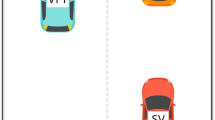Abstract
In this paper, the structured trajectory planning of lane change in collision-free road environment is studied and validated using the vehicle-driver integration data, and a new trajectory planning model for lane change is proposed based on linear offset and sine function to balance driver comfort and vehicle dynamics. The trajectory curvature of the proposed model is continuous without mutation, and the zero-based curvature at the starting and end points during lane change assures the motion direction of end points in parallel with the lane line. The field experiment are designed to collect the vehicle-driver integration data, such as steering angle, brake pedal angel and accelerator pedal angel. The correction Correlation analysis of lane-changing maneuver and influencing variables is conducted to obtain the significant variables that can be used to calibrate and test the proposed model. The results demonstrate that vehicle velocity and Y-axis acceleration have significant effects on the lane-changing maneuver, so that the model recalibrated by the samples of different velocity ranges and Y-axis accelerations has better fitted performance compared with the model calibrated by the sample trajectory. In addition, the proposed model presents a decreasing tendency of the lane change trajectory fitted MAE with the increase of time span of calibrating samples at the starting stage.
Similar content being viewed by others
References
Zhang A M H, Gao Z Y, Ren H L. Incident-based traffic congestion control strategy. Sci China Tech Sci, 2011, 54: 1338–1344
Xiong Z, Sheng H, Rong W G, et al. Intelligent transportation systems for smart cities: a progress review. Sci China Inf Sci, 2012, 55: 2908–2914
Moritz W, Julius Z, Soeren K. Optimal trajectory generation for dynamic street scenarios in a frenet frame. In: Proceedings of the 2010 IEEE International Conference on Robotics and Automation, Anchorage: IEEE, 2010. 987–993
You F, Zhang R H, Guo L, et al. Trajectory planning and tracking control for autonomous lane change maneuver based on the cooperative vehicle infrastructure system. Expert Syst Appl, 2015, 42: 5932–5946
Feng J X, Ruan J H, Li Y B. Study on intelligent vehicle lane change path planning and control simulation. In: Proceedings of the 2006 IEEE International Conference on Information Acquisition, Weihai, 2006. 683–688
You F, Wang R B, Zhang R H. Research on lane changing and overtaking for intelligent vehicle based on vision navigation. In: Proceedings of the 2008 IEEE International Conference on Industrial Technology, Chengdu: IEEE, 2008. 1–6
Yang Z G, Qi Z J, Huang Y. Trajectory planning of lane changing for intelligent vehicles. J Chongqing Jiaotong Univ, 2013, 32: 520–524
Ren D B, Zhang J Y, Zhang J M, et al. Trajectory planning and yaw rate tracking control for lane changing of intelligent vehicle on curved road. Sci China Tech Sci, 2011, 54: 630–642
Damoon S, Azim E, David C. Vehicle collision avoidance maneuver with limited lateral acceleration using optimal trajectory control. J Dyn Sys Meas Control, 2013, 135: 1–12
Kim S, Oh H, Suk J, et al. Coordinated trajectory planning for efficient communication relay using multiple UAVs. Control Engn Pract, 2014, 29: 42–49
Butakov V, Ioannou P. Personalized driver/vehicle lane change models for ADAS. IEEE T Veh Tech, 2015, 64: 4422–31
Soudbakhsh D, Eskandarian A, Chichka D. Vehicle collision avoidance maneuvers with limited lateral acceleration using optimal trajectory control. J Dyn Sys Meas Control, 2013,135: 1–12
Zhang Z H, Yu X C, Jin Z J, et al. Trajectory planning and optimal lateral stability control under multiple barriers for intelligent vehicle. World J Eng Tech, 2015, 3: 100–105
Rossi C, Savino S. Robot trajectory planning by assigning positions and tangential velocities. Robot Com-Int Manuf, 2013, 29: 139–156
Vale A, Fonte D, Valente F, et al. Trajectory optimization for autonomous mobile robots in ITER. Robot Auton Syst, 2014, 62, 871–888
Li A J, Li S M, Shen H, et al. Motion trajectory planning method of lane changing for intelligent vehicle. J Theory App Inf Tech, 2012, 45: 297–302
Hidalgo-Martínez M, Sanmiguel-Rojas E, Burgos M. A. Design of cams with negative radius follower using Bézier curves. Mech Mach Theory, 2014, 82, 87–96
Guo L, Ge P, Yue M, et al. Lane changing trajectory planning and tracking controller design for intelligent vehicle running on curved road. Math Probl Eng, 2014, 2014: 1–9
Behere S, Törngren M, Chen D. A reference architecture for cooperative driving. J Syst Architect, 2013, 59: 1095–1112
Pérez J, Milanés V, Godoy J, et al. Cooperative controllers for highways based on human experience. Expert Syst Appl, 2013, 40: 1024–1033
Author information
Authors and Affiliations
Corresponding author
Rights and permissions
About this article
Cite this article
Wang, J., Zhang, Q., Zhang, Z. et al. Structured trajectory planning of collision-free lane change using the vehicle-driver integration data. Sci. China Technol. Sci. 59, 825–831 (2016). https://doi.org/10.1007/s11431-016-6041-2
Received:
Accepted:
Published:
Issue Date:
DOI: https://doi.org/10.1007/s11431-016-6041-2




